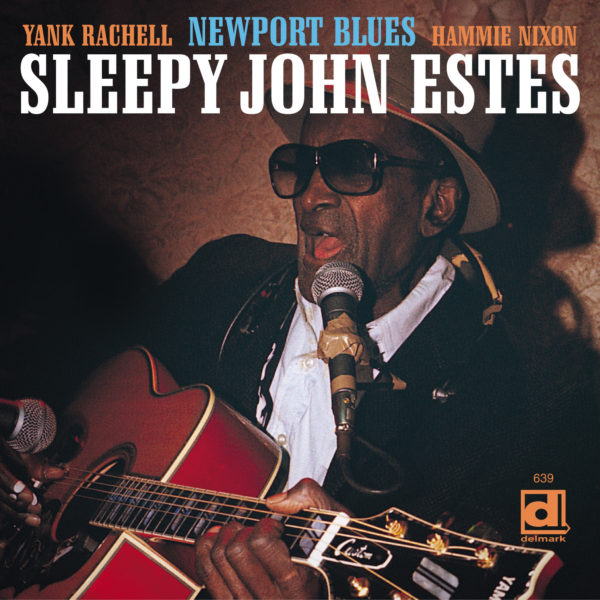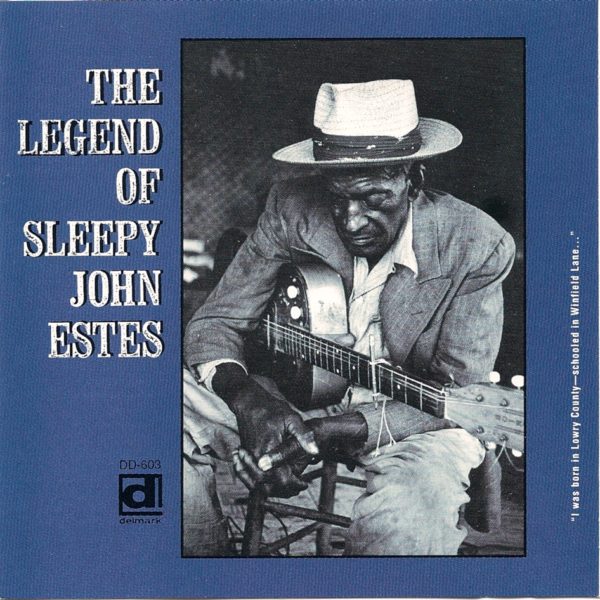ALL of Sleepy John Estes Delmark recordings are now available. Order CDs, download or stream here.
John Adam Estes, known as Sleepy John Estes, January 25 1899 Ripley TN – June 5th 1977 Brownsville TN, was one of the greatest American blues guitarists, songwriters and vocalist. His music influenced such artists as The Beatles, The Rolling Stones, Bob Dylan and Led Zeppelin.
John Adam Estes was born on January 25, 1904 in Ripley, Tennessee. His recording career spanned six decades from the ’20s until his death on June 5, 1977. Sleepy John Estes was one of the most individual of all recorded blues singers. He sang with phrasing that fairly dripped with expressiveness in a high crying tone that seemed often like he was speaking to the listener. The songs he wrote were well suited to this treatment, dealing frequently with his and his neighbors’ lives in Brownsville, Tennessee.
Tennessee blues poet Sleepy John Estes made his recorded debut in 1929 with the song “Broken Hearted, Ragged and Dirty Too”. In ’35 John teamed up with Hammie Nixon and they went on to record many classic sides together until WWII. After a twenty-year absence, Delmark’s Bob Koester rediscovered John and presented him to a new blues audience in 1962. This led to a series of LPs and a reinvigorated career. This album was recorded in November 1974 at concerts in Japan, one of the very first tours of that country by a blues artist – preceded only by a B.B. King State Department appearance. The Estes tour was a great success and even resulted in an Estes track appearing on the Japanese Top 100 chart! Live In Japan.
In the late ’50s Sleepy John Estes wasn’t nearly as visible as he had been before and during World War II — in fact, he had become so obscure that some historians wondered if he had died. But the blues veteran was still very much alive, and in 1962 a 63-year-old Estes (some claimed he was 58 or 57) made an impressive comeback with The Legend of Sleepy John Estes. Produced by Delmark president Bob Koester on March 24, 1962, this historic acoustic session finds singer/guitarist Estes joined by Ed Wilkinson on bass, John “Knocky” Parker on piano, and long-time ally Hammie Nixon on harmonica. Legend isn’t much different from Estes’ recordings of the ’20s, ’30s, and ’40s, and the Tennessee native successfully revisits old favorites like “Divin’ Duck Blues,” “Someday Baby Blues,” “Stop That Thing,” “Milk Cow Blues,” and “Married Woman Blues.”
When Big Joe Williams informed Bob Koester of Delmark Records the Sleepy John Estes was still living, Koester was naturally skeptical. No doubt, the improbability of Estes being alive kept blues researchers from looking for him. Discographies list 1941 as his last recording date. It was Chicagoan David Blumenthal who found him while making a documentary film in Brownsville, Tennessee. Estes was brought to Chicago for an exploratory recording session.

“The Tennessee Blues Poet” was Pete Welding’s description of John Adam Estes, a.k.a. Sleepy John. It correctly emphasizes his ability as a writer of classic blues and hints at the tremendous power of his voice, so ridden with life experience that most assumed he was already in his 80s when he made his first records in 1929. He recorded an album reflecting his poetry, accompanied by fellow Brownsvillians Yank Rachell, mandolin; and Hammie Nixon, harmonica; plus a young Mike Bloomfield quietly adding his powerhouse guitar on four tracks. John went from this album to the Newport Folk Festival, Europe and eventually was a member of the first blues group to tour Japan where he even made the charts.
One of the jewels of Estes’s discography is from 1964. Bob Koester wrote: “Later that year, in a sub-cellar jazz club in Dusseldorf, while John was touring Europe for the first time with the American Folk Blues Festival, John sat in at an impromptu session with Hubert Sumlin (Howling Wolf’s guitarist), Sonny Boy Williamson, Sunnyland Slim and some local musicians. I was amazed at how comfortably John was able to sing with such relative modernists. I promised John that one day we would cut an album with such a sound.”
































